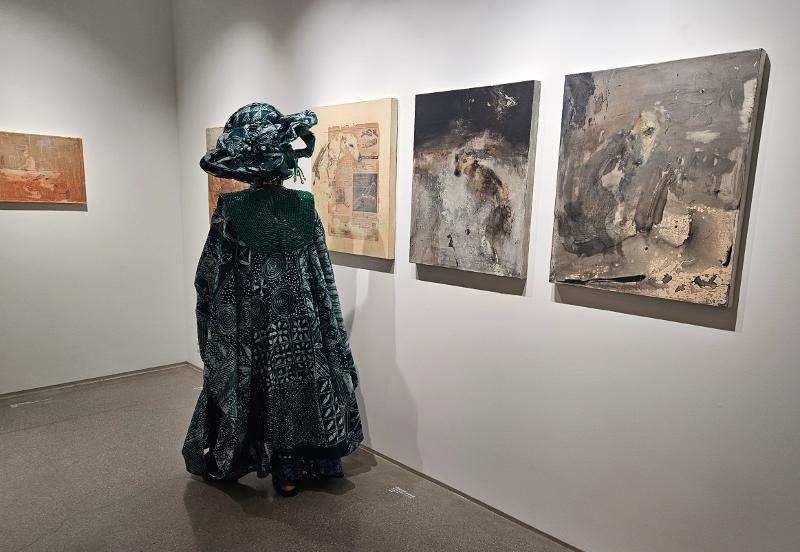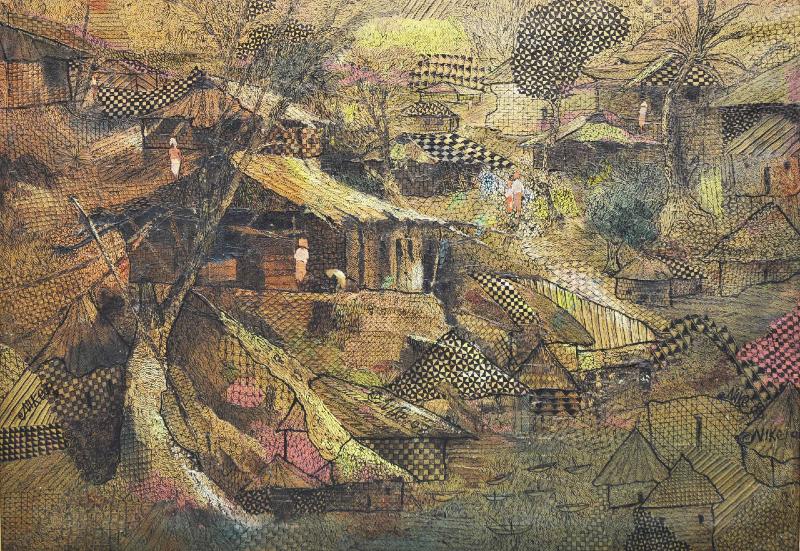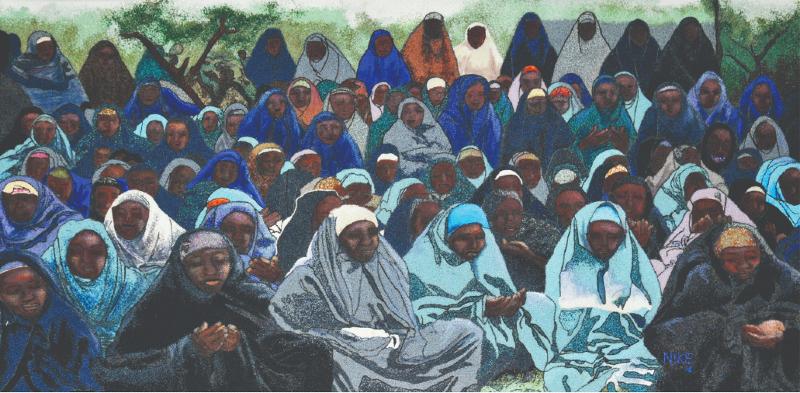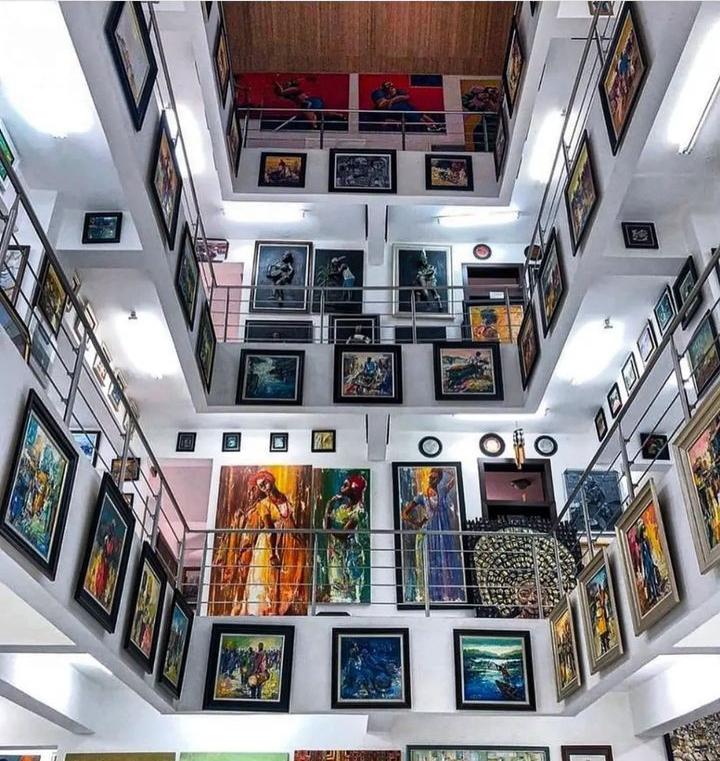
Nike Art Gallery owner and curator Nike Okundaye on Aug. 29 tells Korea.net in an interview her vision for cultural cooperation with Korea at KOCIS (Korean Culture and Information Service) Center in Seoul's Jung-gu District. She is wearing attire she made through a traditional Nigerian dyeing method using bead accessories made with recycled materials from plastic water bottles. (Lee Jun Young)
By Yoon Sojung
"Collaboration to introduce the cultural heritage and similarities of Korea and Nigeria"
This is what Nike Okundaye, 73, owner and curator of the Nigeria-based Nike Art Gallery, has in mind for cultural exchange and cooperation with Korean organizations.
Dubbed "a master artist of Nigerian textile art" for reviving the traditional craft, Okundaye is far more than a textile designer but a pioneer who promotes African art to the world and opens new artistic horizons. She is often called a "champion of African art" as well as affectionately "Mama Nike" by her fellow Nigerians as a sign of respect.
Her works are displayed at many famous museums and galleries worldwide such as the Smithsonian in the U.S. and Goethe-Institut in Germany. Her gallery is the largest facility of its kind in Western Africa, with four branches in Nigeria and some 8,000 works of art.
Many assume that Okundaye had a top-quality education given her renowned status as a textile artist. The truth, however, is exactly the opposite.
Her journey in art and life was full of hardship as she was born to a family of artists mired in poverty, which prevented her from getting a proper education. Overcoming these obstacles, she eventually emerged as an artist who revived traditional Nigerian methods of textile dyeing and reaffirmed the value of art in society.
Okundaye's fame has spread far beyond Nigeria. Leading institutions of higher learning abroad such as Harvard University of the U.S. and Cambridge University of the U.K. have invited her to lecture on traditional African art. She has extensively traveled the world to spread her craft.
The artist is also a crusader for art education for women and support for youth artists. CNN covered her work in its articles "Nigeria's 'Mama Nike' empowers women through art" and "Centuries-old dye tradition makes a comeback."
Okundaye has close ties with Korea, even serving as promotional ambassador for Busan's bid for the 2030 World Expo. Her hope is to introduce Korean art and culture to her home country given their richness comparable to those of Nigeria and open a new chapter in bilateral cooperation through art.
The following are experts from Korea.net's Aug. 25 in-person interview with Okundaye at KOCIS Center in Seoul and a written interview in early September.

Nike Art Gallery owner and curator Nike Okundaye on Aug. 29 looks at works displayed at the Seosomun Main Branch of the Seoul Museum of Art in Seoul’s Jung-gu District. (Ministry of Culture, Sports and Tourism)
What impressed you most during your first trip to Korea?
It's so clean everywhere and people are so kind and disciplined. Nigeria is the largest country in Africa, so we have the rich cultural heritage and diversity of all 54 African nations. It seems Korea is also full of cultural and artistic heritage like us. I was particularly impressed by exhibitions themed on women artists at the Seoul Museum of Art. And at the National Museum of Modern and Contemporary Art (MOMA), I saw a lot of works and felt like they talked to me.
Briefly introduce Nike Art Gallery.
I opened my first gallery in Osogbo in western Nigeria in 1967. My parents were artists and we inherited the family tradition of textile art for five generations. I grew up with nothing and could not go to school. But I succeeded in traditional textile art and that made me what I am today.
In 1974, I was invited to the U.S. to teach African Americans about traditional African arts so that they can learn more about their cultural heritage and roots. I have since traveled around the world to lecture.
At the time, Nigeria had a very small number of female artists so I decided to teach them. When I first opened my art center, I taught about 20 people in the garage. Six months later, I opened an exhibition of their works. Afterward, I encouraged the students to make their own works and teach others what they learned from the center. I later taught trainers of art teachers.
As time passed, we expanded to four centers in Osogbo, Ogidi in southeast Nigeria, Lagos, the largest city in Nigeria, and the capital of Abuja.
I've taught more than 10,000 people so far. In Italy, we taught art education to about 5,000 Nigerian prostitutes, 3,000 of whom changed their life paths thanks to art.
How did you overcome hardship as a child to discover your passion for art?
I lost my mother when I was six and my grandmother the next year. After quitting schooI, I learned traditional textile art from my aunt and great grandmother to make clothes. I marketed myself to sell my works to customers. Although I couldn't speak a word of English at the time, I communicated with customers through body language to win orders.
In fact, my first gallery was in my bedroom. I made my own studio in the backyard of the bedroom. I put a table under the tree and trained in Adire, or traditional Nigerian indigo dyeing. This method involves a particular waxing that did not succeed long but I sought to revive it.
I always pursue something new in art and take a creative approach. The clothes I wear are also made using the traditional dyeing method. I designed these clothes close to the luxurious garments that Nigerian royals wear so that ordinary people with little money can also purchase them. I embroider traditional patterns on fabric. The bead accessories I wear are made from recycled materials originally from plastic water bottles.
Your Nike Art Foundation fights social injustice against women in Africa and helps promising young artists. Will you cooperate with Korea in these areas?
Of course. Korea also has many artists full of creativity. I believe we can work together in a lot of areas such as exchanges between artists of both countries and workshops.
Korean interest in exchange and cooperation with Africa is at a record high, as shown by Seoul's hosting of the inaugural Korea-Africa Summit in June. As the head of a major gallery in Africa, what type of exchange do you want?
I wish for Korea to build a large museum in Nigeria where I can host an exhibition to introduce the cultural heritage of both countries. The two sides have similar histories as they secured independence from colonial rule. In arts, they have more similarities. In addition to cooperation in textile art that I'm considering, I wish for both countries to cooperate in many other areas.
I also wish to collaborate with MOMA or Art Council Korea. I hope to host an exhibition in Seoul and one in Nigeria to introduce the works of Korean artists.

"My Root" by Nike Okundaye, 2008 (Nike Art Gallery)

"Chibok Girls," a 2016 artwork by Nike Okundaye, was inspired by the 2014 abduction of hundreds of girls from a boarding school in the Nigerian town of Chibok by the Islamic terrorist group Boko Haram. (Nike Art Gallery)

Nike Art Gallery, the largest facility of its kind in Western Africa, has four branches in Nigeria. Shown is the interior of the Lagos branch. (Nike Art Gallery)
arete@korea.kr